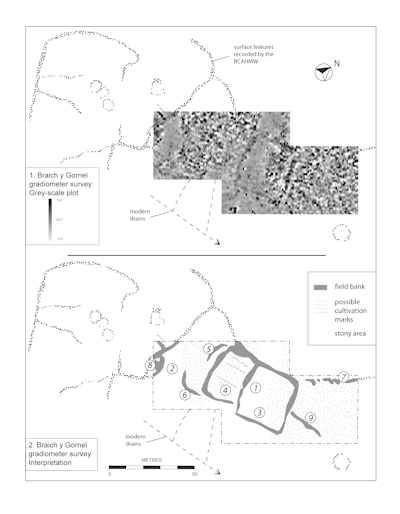
Geophysical survey, aimed at identifying any traces of cultivation, was undertaken and focused on two adjoining sub-rectangular fields (Figure 11): F3 and F4. The survey results were dominated by substantial areas of 'noise', probably caused by large quantities of stone in the soil. Two quieter areas (1 and 2) may have been partly cleared of stone or may be natural variations in the soil.

Two conjoining rectangular enclosures (3 and 4) were detected. These together only partly correspond to field F3, visible on the ground as a low rubble bank. This suggests that the enclosures had been modified and that the south-eastern side and the division belong to an earlier phase. Two faint anomalies (5 and 6) may also correspond to earlier phases. Elsewhere, anomalies (7) and (8) correspond with upstanding walls. A further faint linear anomaly (9), not visible on the ground, may indicate another earlier boundary. The disturbance noted within enclosure (4) appears to contain faint linear features aligned north-east to south-west that respect its boundary and could be interpreted as evidence of contemporary cultivation.
Internet Archaeology is an open access journal based in the Department of Archaeology, University of York. Except where otherwise noted, content from this work may be used under the terms of the Creative Commons Attribution 3.0 (CC BY) Unported licence, which permits unrestricted use, distribution, and reproduction in any medium, provided that attribution to the author(s), the title of the work, the Internet Archaeology journal and the relevant URL/DOI are given.
Terms and Conditions | Legal Statements | Privacy Policy | Cookies Policy | Citing Internet Archaeology
Internet Archaeology content is preserved for the long term with the Archaeology Data Service. Help sustain and support open access publication by donating to our Open Access Archaeology Fund.